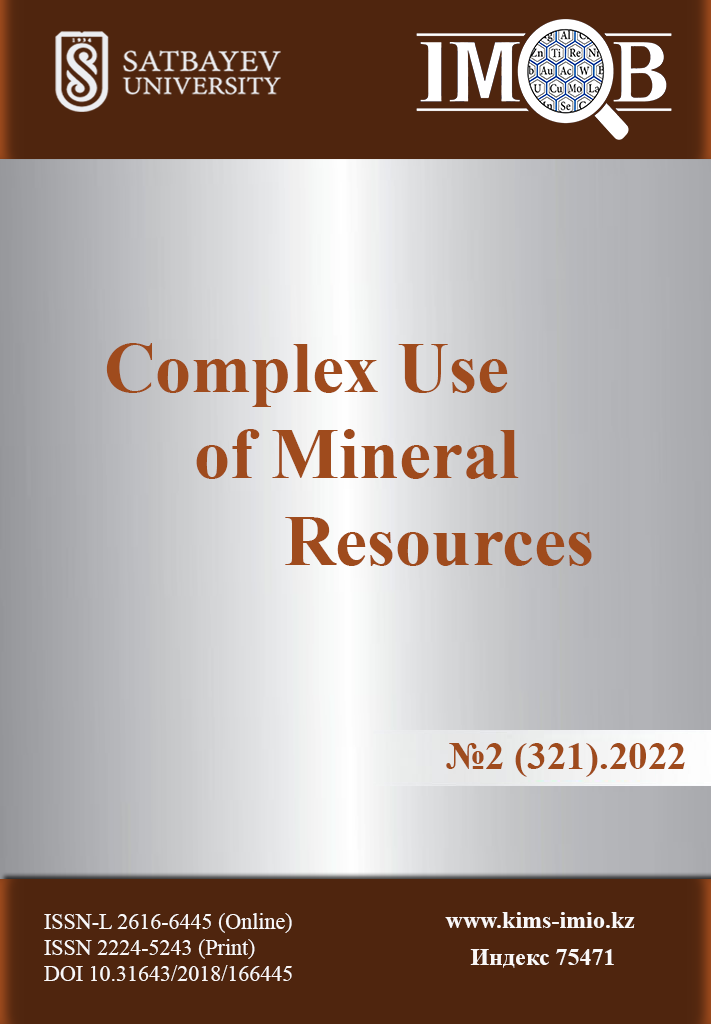Cluster-associate model of the viscosity of potassium carbonat
DOI:
https://doi.org/10.31643/2022/6445.22Keywords:
concept of randomized particles, Boltzmann distribution, dynamic viscosity, potassium carbonate, cluster, associate.Abstract
In the article, the temperature dependence of the viscosity of a complex inorganic substance - potassium carbonate was obtained and the proposed mathematical model was verified. Viscosity is considered as a chaosensitive property of a liquid inherent in it in motion and at rest. The mathematical model of viscosity was developed using the Boltzmann distribution and the concept of chaotic particles. On this basis, a hierarchical cluster-associate viscosity model is constructed, which takes into account not only the formation of primary clusters, but also secondary associates with respect to them, with the possibility of identifying the degree of cluster association. To adapt the cluster-associated model to experimental data, certain data processing techniques have been developed to identify unknown parameters of the model. The method of processing viscosity data using the entire set of three reference points allows you to determine the indicator of the degree of aggregation of associates. When processing the data on the viscosity of potassium carbonate, a high correlation coefficient was established calculated in comparison with reference values, which indicates the adequacy of the new relationship. This model makes it possible to predict the behavior of the viscosity of potassium carbonate in a higher temperature range. The degree of association of clusters with an increase in temperature decreases, corresponding to the dynamics of the destruction of associates and viscosity in general.
Downloads
References
DenisovVM, IstominSA,Denisova LT, KuchumovaOV, RyabovVV. Vyazkost rasplavov Bi2O3-CaO [Viscosity of Bi2O3-CaO melts]. Rasplavy = Melts, 2014;2:12-16. (InRus.)
Konstantinova NYu, Kurochkin AR, Borisenko AV, Filippov VV, Popel PS. Vyazkost rasplavov med-alyumini[Viscosity of copper–aluminum melts].Rasplavy = Melts, 2016;2:157. (InRus.)
Ryabina AV, Shevchenko VG. O vyazkosti zhidkikh metallov [On the viscosity of liquid metals]. Rasplavy = Melts,2017;6:522.(InRus.)
Beltyukov AL, Olyanina NV, Ladianov VI. Osobennosti izmereniya vyazkosti zhidkikh splavov So–Si [Peculiarities of measurement of viscosity of liquid Co–Si alloys]. Rasplavy = Melts,2017;6:470 (In Rus.)
Dobosz Alexandra,Gancarz Tomasz. Reference Data for the Density, Viscosity, and Surface Tension of Liquid Al-Zn, Ag-Sn, Bi-Sn, Cu-Sn, and Sn-Zn Eutectic Alloys. Journalof Physical andChemical ReferenceData,2018;47(1). https://doi.org/10.1063/1.5010151
Nunes V.M.B.,Queiros C.S.G.P.,Lourenco M.J.V.,et al. Viscosity of Industrially Important Zn-Al Alloys Part II: Alloys with Higher Contents of Al and Si. International Journal of Thermophysics, 2018;39(5). https://doi.org/10.1007/s10765-018-2388-x
Zhao Yan,Hou Xiaoxia,Bai Yanwen.Viscosity, structure and fragility of Ag-Si melts. Aip Advances, 2018;8(8). https://doi.org/10.1063/1.5046317
Tyagunov A G, Baryshev EE, Tyagunov GV, Shmakova KYu, Mushnikov VS. Struktura i svoystva Ni–Al splavov v zhidkom sostoyanii [Structure and properties of Ni–Al alloys in the liquid state]. Rasplavy = Melts, 2019;1:24-28. (In Rus.) https://doi.org/10.7868/S0235010619010213
Tasidou KA,Chliatzou ChD,Assael MJ, et al. Reference Correlations for the Viscosity of 13 Inorganic Molten Salts. Journal of Physical and Chemical Reference Data, 2019;48(1). https://doi.org/10.1063/1.5091511
Chikova OA,Tkachuk GA,V'yukhin VV.Viscosity of Cu-Ni Melts. Russian Journal of Physical Chemistry A, 2019;93(2). https://doi.org/10.1134/S0036024419020067
Zhang Fan,Wen Shiyi,Liu Yuling,et al. Modelling the viscosity of liquid alloys with associates. Journal of Molecular Liquids, 2019;291. https://doi.org/10.1016/j.molliq.2019.111345
Uddin Md Salah,Gosh RC,Bhuiyan GM.Investigation of surface tension, viscosity and diffusion coefficients for liquid simple metals. Journal of Non-Crystalline Solids, 2019;499:426-433. https://doi.org/10.1016/j.jnoncrysol.2018.07.014
Gao Shanchao,Jiao Kexin,Zhang Jianliang.Review of viscosity prediction models of liquid pure metals and alloys. Philosophical Magazine, 2019;99(7):853-868. https://doi.org/10.1080/14786435.2018.1562281
Meyer N,Xu H,Wax J-F.The role of chemical order in the temperature and composition dependence of the viscosity of liquid alloys. Journal of Chemical Physics, 2019;150(17). https://doi.org/10.1063/1.5092694
FilippovVV, ShunyaevKYu, Leont'evLI.Temperature and Time Dependences of the Viscosity of InBi-Pb Melts. Doklady Physical Chemistry, 2020;494(1), 139-142. https://doi.org/10.1134/S0012501620090018
Filippov VV, Shunyayev KYu. Vyazkost rasplavov InBi–Pb [Viscosity of InBi–Pb melts]. Rasplavy = Melts, 2020;5:541-547. (InRus.) https://doi.org/10.31857/S0235010620050059
BeltyukovAL,OlyaninaNV. LadianovV.I. Osobennosti izmereniya vyazkosti metallicheskikh rasplavov metodom krutilnykhkolebaniy. Rasplavy = Melts, 2016;2:176.(In Rus.)
Makasheva AM, MalyshevVP. Klasterno-assotsiatnaya model vyazkosti ftorida natriya v sopostavlenii s modelyu Frenkelya [Cluster-associate model of the viscosity of sodium fluoride in comparison with the Frenkel model]. Rasplavy = Melts, 2020;5:480-488. (In Rus.) https://doi.org/10.31857/S0235010620050060
Malyshev VP, Makasheva AM. Vyazkost' i tekuchest' rasplavov v aspekte ih haotizacii (neorganicheskie soedineniya i splavy) [Viscosity and fluidity of melts in terms of their randomization (inorganic compounds and alloys)]. Lambert: Academic Publishing (Germany), 2020;153. (In Rus.)
Malyshev VP, Bekturganov NS, Turdukozhayeva (Makasheva) AM.Vyazkost, tekuchest i plotnost veshchestv kak mera ikh khaotizatsii [Viscosity, fluidity and density of substances as a measure of their chaos].M.: Nauchnyy mir. 2012;288. (in Russ).
Makasheva AM. Klasterno-associatnaya model' vyazkosti i metody opredeleniya ee parametrov[Cluster-associated viscosity model and methods for determining its parameters]. Kompleksnoe ispol'zovanie mineral'nogo syr'ya = Complex Use of Mineral Resources, 2020;2(313):27-37. (In Rus.). https://doi.org/10.31643/2020/6445.14
Malyshev VP, Makasheva AM. Vzaimosvyaz' klasterno-associatnoj modeli vyazkosti zhidkosti s model'yu vyazkosti Frenkelya-Andrade [Relationship between the cluster-associate model of fluid viscosity and the Frenkel-Andrade viscosity model]. Izvestiya Rossijskoj Akademii nauk = Russian Chemical Bulletin, Ser. him. 2020;7:1296-1305.. (In Rus.) https://doi.org/10.1007/s11172-020-2901-9
Aleksandrov VD, Frolova SA, Pokintelitsa EA, Zozulya AP, Amerkhanova ShK. Dinamika izmeneniya klasternoy struktury rasplavov v protsesse ravnovesnoy i neravnovesnoy kristallizatsii[Dynamics of changes in the cluster structure of melts during equilibrium and non-equilibrium crystallization]. Rasplavy = Melts, 2017;6:484.(In Rus.)
PozinME. Tekhnologiya mineralnykh soley (udobreniy, pestitsidov, promyshlennykh soley, okislov i kislot) [Technology of mineral salts (fertilizers, pesticides, industrial salts, oxides and acids)] Ch. I i II, 4-e, ispr.,L.: Khimiya. 1974;792. (in Russ).
Morachevskiy AG. Elektroprovodnost. plotnost i vyazkost individualnykh rasplavlennykh soley: spravochnik po rasplavlennym solyam[Electrical conductivity, density and viscosity of individual molten salts: Handbook of molten salt]T. 1. Perevod s angl. i s dop.–Leningradskoye otd-e: Khimiya. 1971;168.(In Rus.)
Volkov AI, ZHarskij IM. Bol'shoj himicheskij spravochnik[Big chemical reference book]. –Mn.: Sovremennaya shkola, 2005:608. (In Rus.)
Janz GJ, Saegusa F. Molten Carbonatesas Electrolytes: Viscosity and Transport PropertiesJ. Electrochem. Soc. 1963;110: 452.
Vorobyev GV, Palguyev SF, Karpachev SV. Trudy Instituta elektrokhimii UFAN SSSR [Proceedings of the Institute of Electrochemistry UFAN USSR]. 1965;6:39.(in Russ).
Downloads
Published
How to Cite
Issue
Section
License
Copyright (c) 2022 Bekbayeva, L., Malyshev, V., Mamyachenkov, S., & Makasheva, A.

This work is licensed under a Creative Commons Attribution-NonCommercial-NoDerivatives 3.0 Unported License.


























